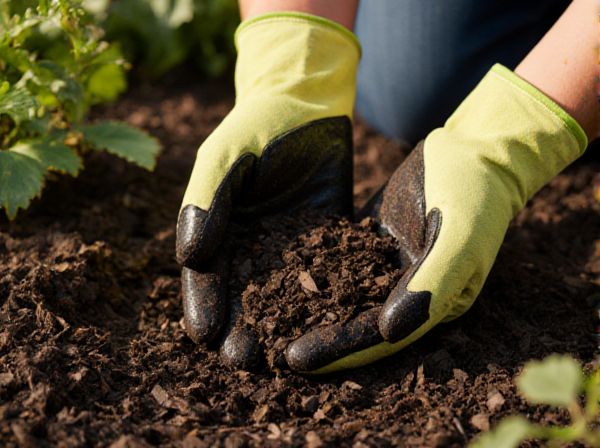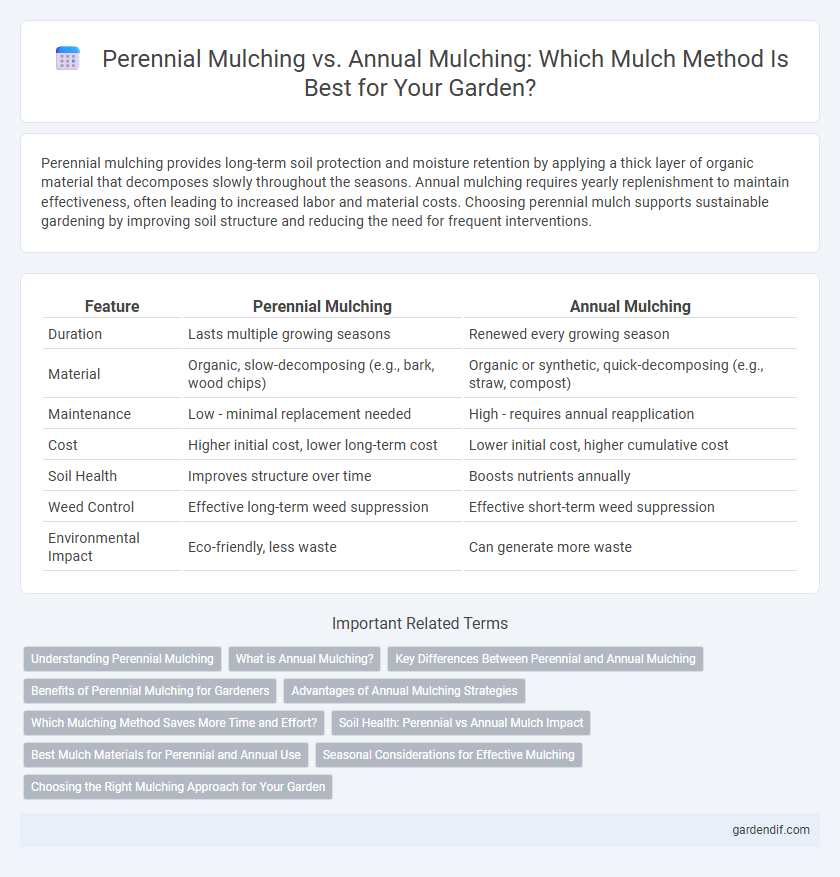
Perennial mulching vs annual mulching Illustration
Perennial mulching provides long-term soil protection and moisture retention by applying a thick layer of organic material that decomposes slowly throughout the seasons. Annual mulching requires yearly replenishment to maintain effectiveness, often leading to increased labor and material costs. Choosing perennial mulch supports sustainable gardening by improving soil structure and reducing the need for frequent interventions.
Table of Comparison
| Feature | Perennial Mulching | Annual Mulching |
|---|---|---|
| Duration | Lasts multiple growing seasons | Renewed every growing season |
| Material | Organic, slow-decomposing (e.g., bark, wood chips) | Organic or synthetic, quick-decomposing (e.g., straw, compost) |
| Maintenance | Low - minimal replacement needed | High - requires annual reapplication |
| Cost | Higher initial cost, lower long-term cost | Lower initial cost, higher cumulative cost |
| Soil Health | Improves structure over time | Boosts nutrients annually |
| Weed Control | Effective long-term weed suppression | Effective short-term weed suppression |
| Environmental Impact | Eco-friendly, less waste | Can generate more waste |
Understanding Perennial Mulching
Perennial mulching involves applying organic or inorganic materials once and maintaining them over multiple growing seasons, promoting long-term soil health and moisture retention. This method reduces labor and material costs compared to annual mulching, which requires yearly reapplication for effective weed suppression and erosion control. Understanding perennial mulching helps gardeners and landscapers optimize sustainability by enhancing microbial activity and stabilizing soil structure over time.
What is Annual Mulching?
Annual mulching involves applying a fresh layer of mulch once every year to protect soil, retain moisture, and suppress weeds during the growing season. This method requires replenishing organic materials such as wood chips, straw, or compost annually to maintain soil health and fertility. Annual mulching supports seasonal plant growth cycles by providing a nutrient boost and improving soil structure yearly.
Key Differences Between Perennial and Annual Mulching
Perennial mulching involves using long-lasting organic materials like wood chips or bark that decompose slowly, providing continuous soil benefits such as moisture retention, temperature regulation, and improved soil structure over multiple growing seasons. Annual mulching typically uses fast-decomposing materials like straw or compost, requiring yearly reapplication to maintain soil health and weed control. Key differences include longevity, nutrient release rate, and maintenance frequency, making perennial mulching more cost-effective long-term while annual mulching offers quicker nutrient cycling for seasonal crops.
Benefits of Perennial Mulching for Gardeners
Perennial mulching enhances soil structure by providing consistent organic matter, improving moisture retention and nutrient availability year-round. Gardeners benefit from reduced labor and material costs as perennial mulches do not require annual reapplication, promoting sustainable gardening practices. This method also supports beneficial microbial activity and suppresses weed growth more effectively than annual mulching.
Advantages of Annual Mulching Strategies
Annual mulching strategies offer enhanced soil nutrient replenishment by allowing tailored application of organic materials each year, promoting optimal plant growth. These methods improve moisture retention and reduce weed growth seasonally, adapting to specific crop or garden needs. Frequent mulching also minimizes soil erosion and fosters microbial activity, supporting long-term soil health and productivity.
Which Mulching Method Saves More Time and Effort?
Perennial mulching requires less frequent application, significantly reducing time and labor compared to annual mulching, which demands yearly replenishment. Using durable materials like wood chips or bark in perennial mulch creates a long-lasting barrier that suppresses weeds and conserves soil moisture over multiple growing seasons. Choosing perennial mulch optimizes garden maintenance by minimizing repetitive tasks and maximizing resource efficiency.
Soil Health: Perennial vs Annual Mulch Impact
Perennial mulching enhances soil health by providing continuous organic matter that improves soil structure, moisture retention, and microbial activity year-round. Annual mulching offers short-term benefits but can disrupt soil ecosystems due to seasonal removal and reapplication, which may limit long-term nutrient cycling. Consistent organic input from perennial mulch fosters a more stable and resilient soil environment compared to the temporary coverage of annual mulch.
Best Mulch Materials for Perennial and Annual Use
Organic mulches like bark chips and shredded leaves excel for perennial mulching due to their slow decomposition, enriching soil structure and moisture retention over multiple seasons. Annual mulching benefits most from faster-decomposing materials such as straw or composted grass clippings, which provide immediate nutrient release and easier seasonal replacement. Selecting mulch materials based on longevity and nutrient needs enhances plant health and soil quality in both perennial and annual gardening contexts.
Seasonal Considerations for Effective Mulching
Perennial mulching involves applying organic or synthetic material once to support year-round soil health and moisture retention, reducing erosion and temperature fluctuations throughout all seasons. Annual mulching requires seasonal reapplication, typically in spring or fall, to protect new growth, suppress weeds, and adapt to changing weather conditions such as increased rainfall or frost risk. Understanding local climate patterns and plant life cycles ensures effective timing and material choice, maximizing mulching benefits for soil fertility and plant vigor.
Choosing the Right Mulching Approach for Your Garden
Perennial mulching involves applying organic or inorganic materials that decompose slowly, providing long-lasting soil protection and moisture retention, ideal for established plants and reducing maintenance efforts. Annual mulching requires reapplication each season, offering flexibility for different crops and enabling soil nutrient adjustment based on seasonal needs. Selecting the right mulching approach depends on plant types, garden goals, and maintenance preferences to optimize soil health and plant growth.
Perennial mulching vs annual mulching Infographic

 gardendif.com
gardendif.com